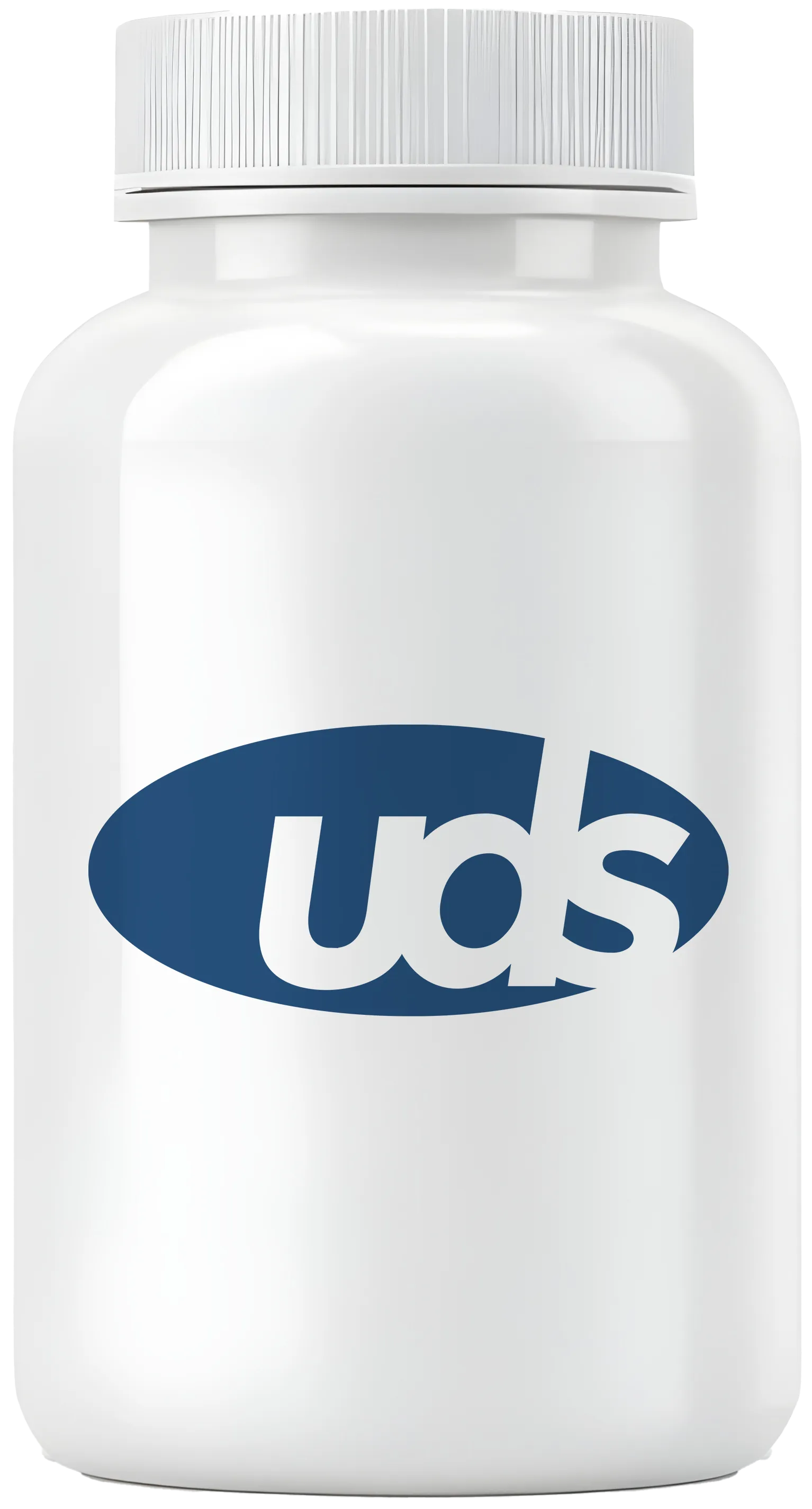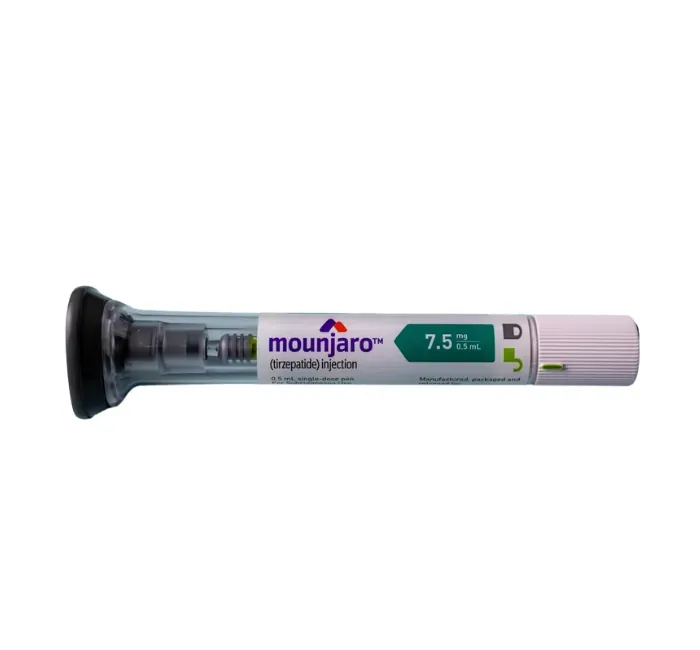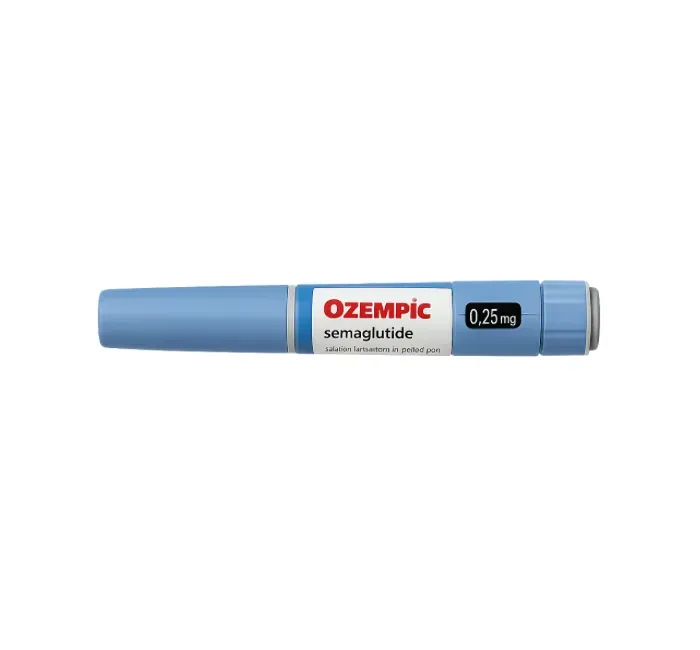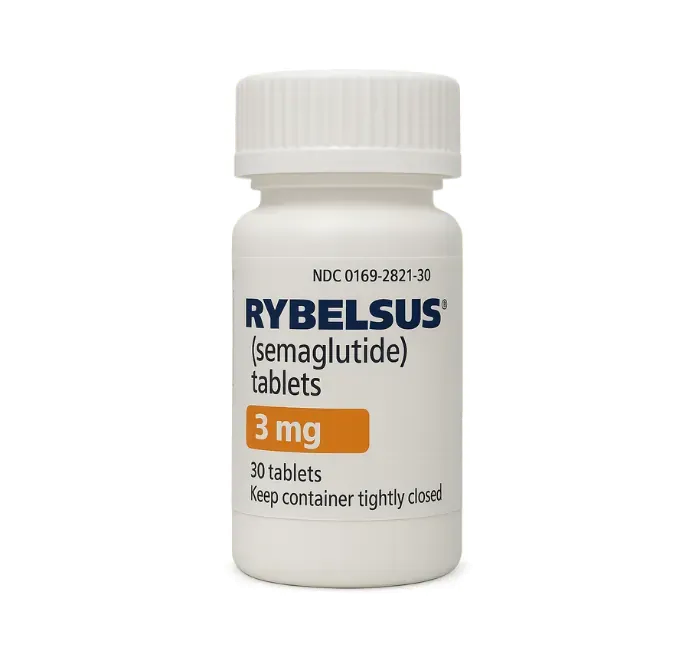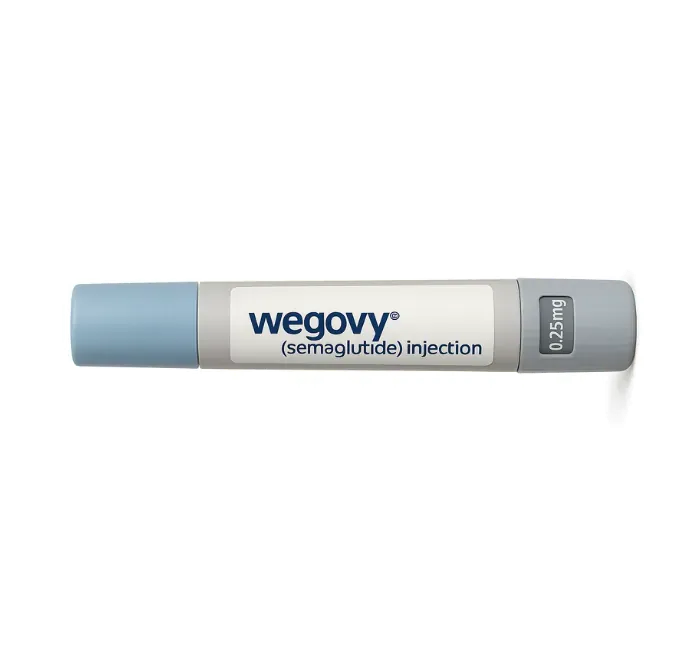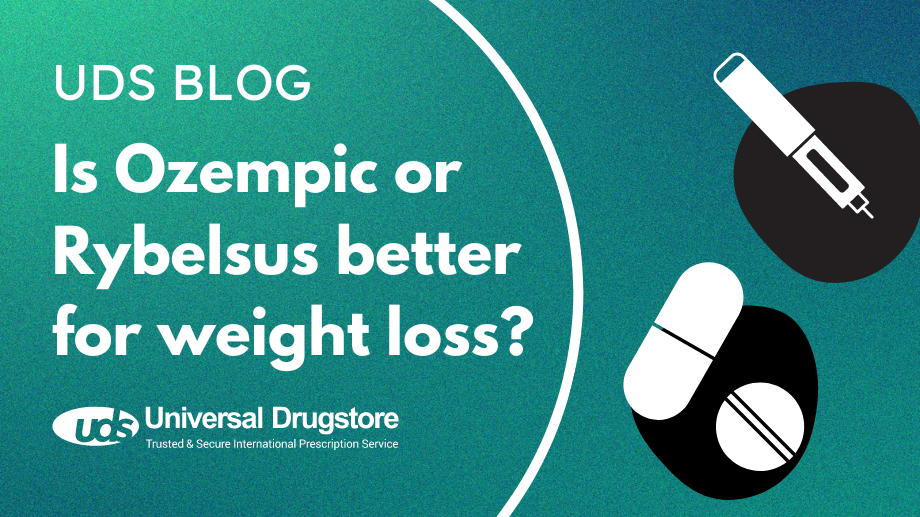How does Rybelsus work?
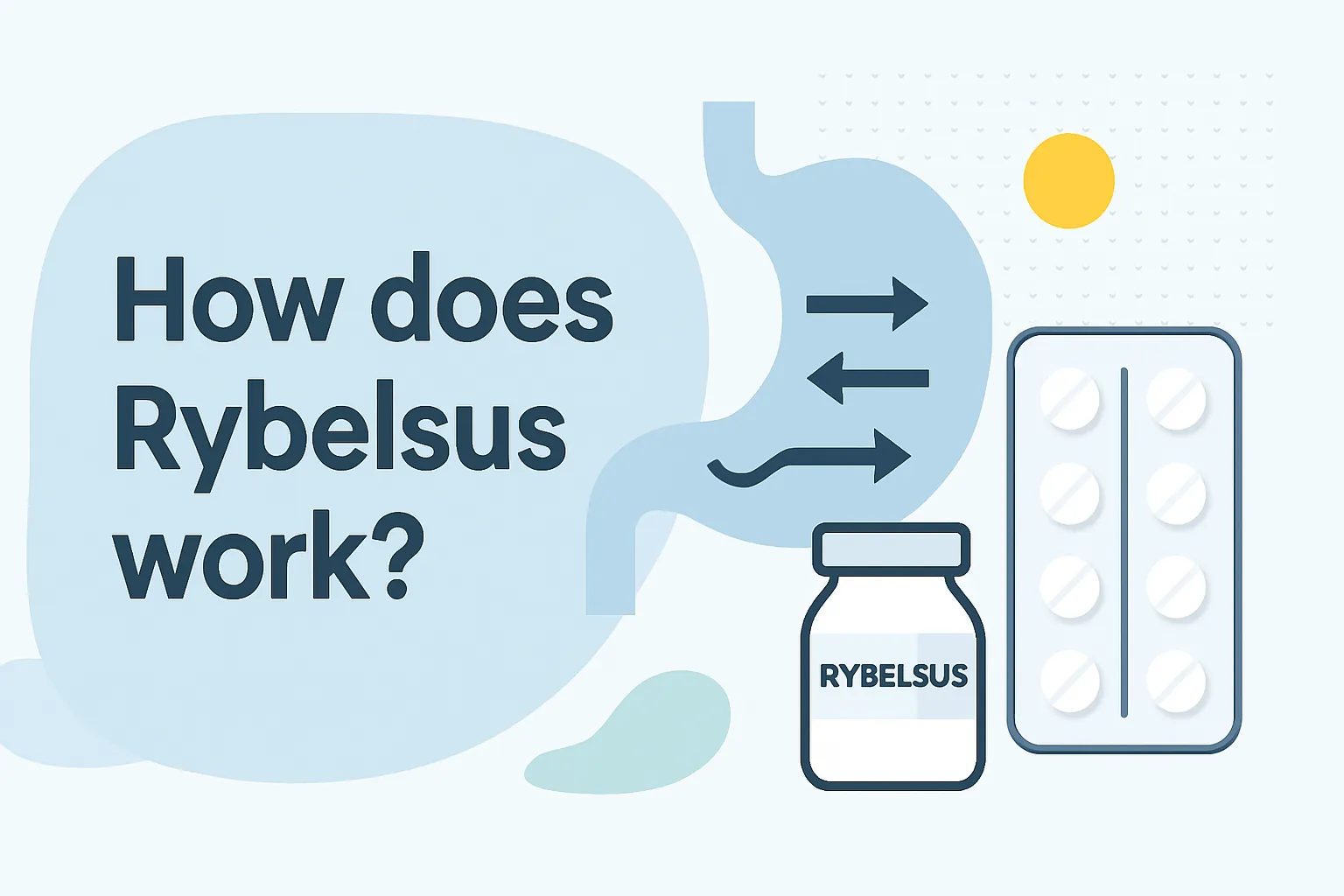
Rybelsus (semaglutide) is an oral medication that is FDA-approved to lower blood glucose levels in adults with type 2 diabetes mellitus (T2DM) when used along with diet and exercise.
The active ingredient in Rybelsus is semaglutide and is part of a class of drugs called glucagon-like peptide 1 or GLP-1 receptor agonists. GLP-1 is a natural hormone released by your gut in response to food. Rybelsus is basically a man-made version of GLP-1. After it binds to the GLP-1 receptor, Rybelsus stimulates insulin release from the pancreas and reduces the amount of glucagon secreted by your liver. This helps lower blood sugar levels in type 2 diabetics. It also slows down gastric emptying or how fast your stomach digests food. This helps you feel full sooner and eat less, which can lead to weight loss. Because of this, Rybelsus is sometimes used off-label to help with weight management in obese people.
Read on as we go over all the important information you need to know about Rybelsus and answer some frequently asked questions.
Rybelsus FAQs
What is Rybelsus?
Rybelsus (semaglutide) is a brand-name prescription drug manufactured by Novo Nordisk. It is approved by the U.S. Food and Drug Administration (FDA) along with a low-calorie diet and exercise to control blood sugar levels in adults with T2DM. It is also sometimes used off-label as a weight loss drug.
Rybelsus is not approved to treat type 1 diabetes (T1DM).
What is the best way to use Rybelsus?
Your healthcare provider will determine the dose of Rybelsus that is right for you. You will take Rybelsus on an empty stomach when you first wake up at least 30 minutes before your first food, drink, or other oral meds. You should swallow the tablet whole with a sip of water (no more than 4 ounces). Don’t crush, split, or chew the tablet. If you miss a dose, skip the missed dose and go back to your regular schedule.
What drug interactions are there with Rybelsus?
When Rybelsus is taken with other drugs, it can change how they work or make some side effects more likely or severe. You should ask your healthcare provider if any of the prescription medications, over-the-counter (OTC) drugs, vitamins, or supplements you take may interact with Rybelsus, including:
- Other diabetic medications such as insulin, sodium-glucose co-transporter-2 (SGLT-2) inhibitors, sulfonylureas, and metformin
- Oral medications, since Rybelsus decreases how fast your stomach empties and can change how well these drugs are absorbed
What are the possible side effects of Rybelsus?
The most common side effects of Rybelsus seen in clinical trials when compared to placebo include:
- Nausea
- Vomiting
- Abdominal pain
- Diarrhea
- Decreased appetite
- Weight loss
- Constipation
Other possible side effects of Rybelsus can include:
- Indigestion
- Acid reflux
- Gas
- Bloating
Rarely, Rybelsus may cause some more serious side effects such as:
Serious, life-threatening allergic reactions with symptoms such as:
- Hives
- Swelling of your face, tongue, or throat
- Trouble breathing
Increased risk of certain thyroid tumors including medullary thyroid carcinoma (MTC) or a certain inherited disease (multiple endocrine neoplasia syndrome type 2 or MEN 2) with symptoms such as:
- Lump or swelling in your neck
- Trouble swallowing
- Hoarseness
- Shortness of breath
Pancreatitis with symptoms such as:
- Severe pain in your upper stomach that spreads to your back
- Nausea with or without vomiting
- Fast heart rate
Complications from diabetic retinopathy. Tell your healthcare provider if you have any vision changes while taking Rybelsus.
Shop Medications
Low blood sugar (hypoglycemia) with symptoms such as:
- Sweating
- Blurred vision
- Lightheadedness or dizziness
- Anxiety, irritability, or other mood changes
- Excessive hunger
- Slurred speech
- Confusion
- Drowsiness
- Headache
- Feeling jittery
- Fast heartbeat
Kidney problems including signs of dehydration such as:
- Feeling thirsty
- Dry skin
- Urinating less
Gallbladder problems/gallstones with symptoms such as:
- Fever
- Pain in the upper part of your stomach
- Clay-colored stool
Contact your healthcare professional for medical advice about any possible adverse effects you experience while taking Rybelsus. You can report your adverse effects to the FDA at 1-800-FDA-1088 or www.fda.gov/medwatch.
Is Rybelsus safe?
When taken as directed, Rybelsus is generally well-tolerated and safe. However, there are some people who should not take this medication. Rybelsus should not be taken if you are allergic to semaglutide or any inactive ingredients in this product. You should also avoid this medication if you have a personal or family history of a certain type of thyroid cancer called medullary thyroid carcinoma or if you have Multiple Endocrine Neoplasia syndrome type 2.
Rybelsus can also rarely cause some serious side effects. These can include inflammation of your pancreas, vision changes, gallstones, and kidney problems.
What should your healthcare provider know before you start taking Rybelsus?
Your healthcare provider should know any other medical condition you have before starting Rybelsus, including:
- Family or personal history of medullary thyroid carcinoma (MTC)
- Multiple Endocrine Neoplasia syndrome type 2
- Kidney or pancreas problems
- Vision problems relating to your T2DM
- Taking medications for a thyroid condition such as Synthroid (levothyroxine)
- Are pregnant or plan to become pregnant
- Are breastfeeding or plan to breastfeed
How does Rybelsus work for weight loss?
While Rybelsus is only FDA-approved to treat T2DM, it has been used off-label as a weight loss medication to treat obesity. Because it can slow down how fast your stomach empties, it can make you feel fuller sooner. This can lead to you eating less and losing weight. A recent clinical study found that people who took oral semaglutide saw a 15% decrease in their body weight compared to those who took a placebo.
How long does it take for Rybelsus to start working?
Rybelsus is typically started at a low dose (3 mg once daily for 30 days) to reduce your risk of side effects. You will probably not see many benefits until your dose is increased to 7 mg once daily after the initial 30 days. Because it will take 4 to 5 weeks for it to reach a steady level in your bloodstream, it may take 2 to 3 months before you see the full effects of Rybelsus. If the 7 mg dose is not working, your healthcare provider may increase it to 14 mg once daily after 30 days on this dose.
What is the recommended dose for Rybelsus?
To help reduce your risk of side effects, you will start low and slowly increase your dose of Rybelsus. Your dosing schedule for Rybelsus is as follows:
- 3 mg once daily for 30 days. This dose is intended for treatment initiation and is not effective in controlling blood sugar levels.
- Increase the dose to 7 mg once daily after 30 days of taking 3 mg once daily.
- Your dose may be increased to 14 mg once daily if additional blood sugar control is needed after at least 30 days on the 7 mg dose.
Is Rybelsus the same as Ozempic?
Ozempic and Rybelsus contain the same active ingredient, semaglutide. They are both used to treat T2DM and are often prescribed off-label to help you lose weight. The main difference between these 2 medications is how they are taken. Rybelsus is a tablet you take by mouth, while Ozempic is an injection you give under your skin (subcutaneous). Rybelsus is a good alternative option if you have difficulty with injections.
Related Medications
- Wegovy (semaglutide)
- Ozempic (semaglutide)
- Mounjaro (tirzepatide)
- Saxenda (liraglutide)
- Victoza (liraglutide)
- Trulicity (dulaglutide)
Sources
- Rybelsus Prescribing Information
- Rybelsus Medication Guide
- Medscape
- Prescriber’s Digital Reference
- Knop FK, Aroda VR, do Vale RD, Holst-Hansen T, Laursen PN, Rosenstock J, Rubino DM, Garvey WT; OASIS 1 Investigators. Oral semaglutide 50 mg taken once per day in adults with overweight or obesity (OASIS 1): a randomized, double-blind, placebo-controlled, phase 3 trial. Lancet. 2023 Aug 26;402(10403):705-719. doi: 10.1016/S0140-6736(23)01185-6. Epub 2023 Jun 26. PMID: 37385278.
